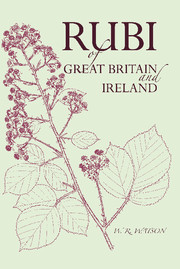Book contents
- Frontmatter
- Foreword
- Preface
- Contents
- INTRODUCTION
- I Environmental variations
- II Genetic intraspecific variations
- III Chromosomes and genes
- IV Reproduction
- V The species in Rubus
- VI Ecesis and migration
- VII Enemies, pests and diseases
- VIII Classification
- IX Collection and identification
- X Characteristics of the British-Irish bramble flora
- XI Cultivating native blackberries for fruit
- XII Note on the nomenclatural type species for the genus Rubus and subgenus Rubus
- XIII Key to the vice-county numbers
- XIV Signs and abbreviations
- ARRANGEMENT OF THE GENUS RUBUS LINN. IN AN ANALYTICAL KEY
- DESCRIPTIONS
- DRAWINGS
- Glossary
- Principal works consulted
- Index
IX - Collection and identification
Published online by Cambridge University Press: 05 June 2016
- Frontmatter
- Foreword
- Preface
- Contents
- INTRODUCTION
- I Environmental variations
- II Genetic intraspecific variations
- III Chromosomes and genes
- IV Reproduction
- V The species in Rubus
- VI Ecesis and migration
- VII Enemies, pests and diseases
- VIII Classification
- IX Collection and identification
- X Characteristics of the British-Irish bramble flora
- XI Cultivating native blackberries for fruit
- XII Note on the nomenclatural type species for the genus Rubus and subgenus Rubus
- XIII Key to the vice-county numbers
- XIV Signs and abbreviations
- ARRANGEMENT OF THE GENUS RUBUS LINN. IN AN ANALYTICAL KEY
- DESCRIPTIONS
- DRAWINGS
- Glossary
- Principal works consulted
- Index
Summary
The stem in many plants furnishes differences so essential that when it is wanting there is no certainty as to the species.
linnaeus, Philosophia (1780, 2nd ed.), 218One Rubus referee used to say ‘No stem-piece, no name’. In Rubus the stem is furnished with various types of deposit, as pruina or wax, and outgrowths such as hairs single, paired, or small and clustered, glands sessile, subsessile or stalked, acicles short or long, sometimes gland-tipped, pricklets and prickles. These are the most typically developed parts for purposes of identification, especially as to frequency, on the middle part of the non-flowering stem growing in the open and belonging to a mature and vigorous plant, and on a panicle growing on the middle part of the two-year-old stem. The character of the armature is, within limits, of more importance than the amount; it will be seen to vary even between the lower and the upper part of a single internode; it is always more advanced on the panicle than on the stem.
The colour of the unripe fruit is worthy of notice; for instance, very pale green in R. dasyphyllus, coral red in R. Bakeranus, blood red in R. rufescens and R. obscurus, fuscous in R. phaeocarpus and R. euryanthemus.
Very important is the direction taken by the sepals under the green fruit. It may be possible to judge this sometimes before the bush has passed entirely out of flower, but more often a second visit will have to be paid.
Before concluding that the stem and panicle are eglandular it is advisable to look at the central petiolule of a stem leaf, at the petiole of a leaf situated below the base of the panicle, and at the upper pedicels and the calyx, as it is at these points if anywhere that glands will be in evidence.
Before accepting that the stem is glabrous, the base and the growing point, or in a specimen the area close to a leaf-base, should be examined. In some species the hairs disappear with age.
- Type
- Chapter
- Information
- Handbook of the Rubi of Great Britain and Ireland , pp. 18 - 20Publisher: Cambridge University PressPrint publication year: 2013



